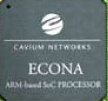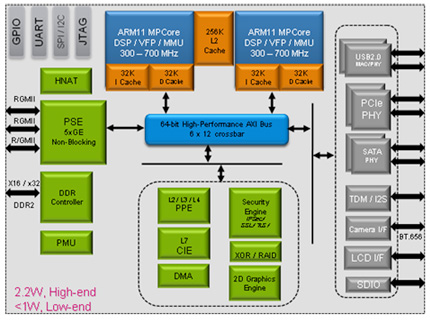MontaVista Android platform targets single-Watt ARM11 SoCs
Oct 25, 2010 — by Eric Brown — from the LinuxDevices Archive — 2 viewsMontaVista Software announced the availability of an Android reference platform for the Econa CNS3xxx ARM11-based processors manufactured by its parent company Cavium Networks. The reference platform offers support for on-chip hardware acceleration blocks, and integrates drivers for peripherals including Bluetooth, 802.11n, and touchscreens, says MontaVista.
The Econa reference platform is aimed at the digitally connected home and office applications, such as FTTx broadband gateways, networked storage, Internet streaming devices, and SMB gateways, says MontaVista. The reference platform is based on the MontaVista Rapid Deployment Program for Android, which MontaVista released in April.
MontaVista's Android reference platform for the  Econa includes a commercial quality Linux port to the Econa CNS3XXX platform, says the company. It is unclear whether there is also an additional hardware component to the platform.
Econa includes a commercial quality Linux port to the Econa CNS3XXX platform, says the company. It is unclear whether there is also an additional hardware component to the platform.
Features are said to include:
- Support for the appropriate on-chip hardware acceleration blocks, including graphics acceleration
- Drivers for peripherals including Bluetooth, 802.11n, and "Touch Panel Display"
- Hardware Abstraction Layer (HAL) integration for Android 2.2 ("Froyo") framework.
- DLNA (Digital Living Network Alliance) Digital Media Server (DMS) library integration with Android
The Rapid Deployment platform that forms the foundation of MontaVista's Econa reference platform for Android features a system-wide Automated Test and Validation Suite, as well as integrated IPTV, DTV, and video on-demand engines. The platform was initially released for Texas Instruments' ARM Cortex-based OMAP3x and MIPS Technologies' MIPS platforms.
Whereas MontaVista owner Cavium is primarily known for its MIPS64-based Octeon processors, the company introduced an ARM11-based Econa CNS3xxx line of system-on-chips (SoCs) in September 2009.

Econa CNS3xxx block diagram
Cavium initially sampled the single-core, 200MHz Econa CNS21xx model, made available with a network module called the CNS2135-TK. The Linux-based Econa CNS3xxx Software Development Kit (SDK), meanwhile, builds upon the existing Octeon/Octeon Plus SDKs, and includes Linux SMP, GNU toolchain, and simple executive for fast path applications, said Cavium at the time.
When the Econa line was announced, which was prior to Cavium acquiring MontaVista, MontaVista rival Wind River said it would also support the Econa line with Wind River Linux. Earlier this year, Wind River said its Wind River Workbench 3.2, Wind River On-Chip Debugging 3.2, and Wind River Compiler 5.8 had added support for the Econa platform.
MontaVista recently announced a major upgrade to its MontaVista Linux Carrier Grade Edition (CGE). CGE 6.0 features a multicore resource management scheme for virtualization, adds support for Linux Containers, KVM, and EMVisor virtualization schemes, and upgrades OpenSAF support and power management features.
Availability
The MontaVista Econa reference platform for Android is available now, says MontaVista, which did not list pricing. Detailed test and quality assurance reports are also available, says the company. More information on MontaVista's Android services and software may be found here.
More information on Cavium Networks' Econa line of processors may be found here.
This article was originally published on LinuxDevices.com and has been donated to the open source community by QuinStreet Inc. Please visit LinuxToday.com for up-to-date news and articles about Linux and open source.